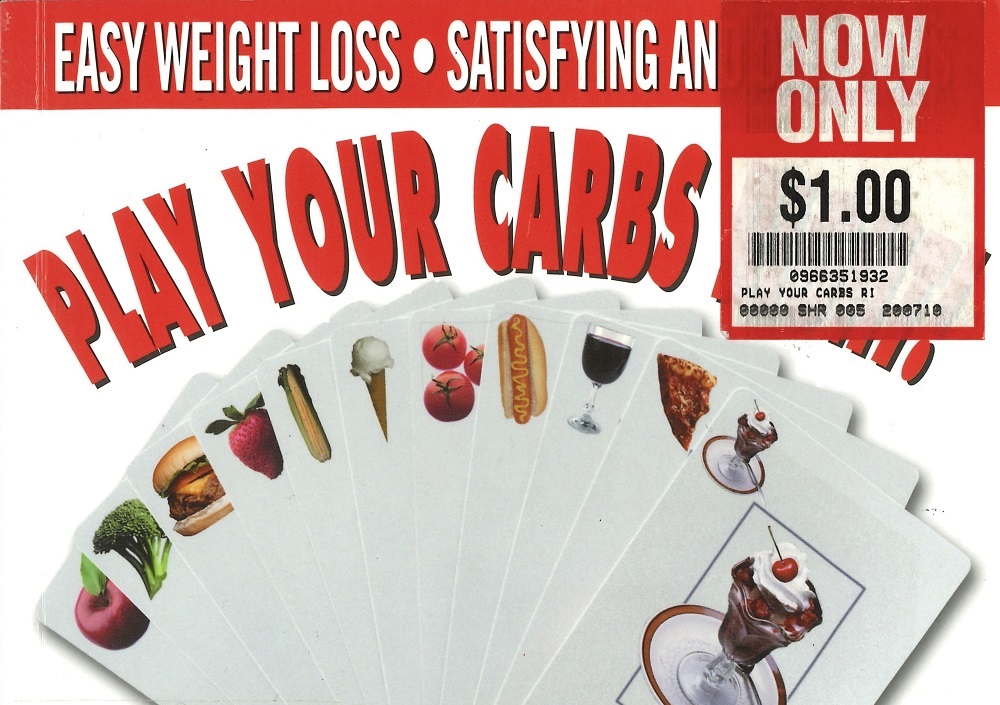Diet Gospel
H. Leighton Steward’s Sugar Busters!
Published: May 31, 2023
Last Updated: August 31, 2023

Shamrock Publishing
Ted and Ella Brennan’s Play Your Carbs Right! Was one of many cookbooks that tried to capitalize on the Sugar Busters! premise.
If you’re, say, over the age of thirty-five, the only conceivable reason you might not remember this fad diet is if you spent the late 1990s in a self-induced sugar coma. Sugar Busters! buffs swore off what they called “insulin-stimulating” carbohydrates and starches: both refined (white bread, white rice, the whole array of sweet and snacky foods) and naturally occurring carbs (most fruit, corn, the humble potato). No need to count calories, as long as you accept the dictum that “sugar is toxic!”
Those words appear in the introduction to Sugar Busters!: Cut Sugar to Trim Fat, a thin, self-published volume released in 1995. Authored by H. Leighton Steward and three New Orleans doctors—none of them certified dietitians or nutritionists—Sugar Busters! combines weight-loss inspiration and recipes with some truth—too much sugar is, in fact, toxic —and heapings of what many detractors have denounced as pseudoscience. The book found a mass audience, becoming one of Louisiana’s all-time bestselling titles, perhaps due to timing. In 1996, the year following the publication of Sugar Busters!, the phrase “obesity epidemic” entered the American vernacular. A panic ensued.
The diet, or “lifestyle” in Sugar Busters!-speak, was the brainchild of Steward, whose name appears first on the cover. A lifelong oilman from east-central Texas, he became one of the nation’s most powerful petroleum executives: chief of operations for Shell, president of the Louisiana Land and Exploration Company, chairman of the US Oil and Gas Association.
Friends introduced Steward to the teachings of previous anti-sugar activists, including the actress Gloria Swanson, who helped her husband, William Dufty, compose the book Sugar Blues, which compares sugar to heroin, and Michel Montignac, a French chef whose hugely successful cookbook Je mange donc je maigris!—a Cartesian pun that translates to “I eat therefore I get thin!”—encouraged followers to gorge on foie gras, dark chocolate, and plenty of cheese. Avoiding sugar, of course, was nothing new in culinary circles. “Carnivorous animals never grow fat,” proclaims the “King of the Gastronomes,” Jean Anthelme Brillat-Savarin in his 1825 masterpiece, The Physiology of Taste: Or Meditations on Transcendental Gastronomy. “All animals that live on farinaceous [starchy] food grow fat willy-nilly,” the French epicure writes, “and man is no exception to the universal law.”
One would think, in the land of a cuisine built on rice, sugar cane, and po-boys, that Sugar Busters! wouldn’t stand a chance. But Steward knew his audience. The diet not only promoted the consumption of red meat but also red wine. “A glass of wine has less sugar than an ear of corn,” the book points out.
The perfect diet for the end of the American century, Sugar Busters! unabashedly blended the languages of the boardroom and the Bible. “Insulin is the maestro, the conductor, the chief,” its authors assert. “It is the CEO of metabolism.” Sugar Busters! was, in its own estimation, a “good-news book.” A book unafraid to spread a new gospel while misquoting scripture. “The old holy books of the world’s leading religions do not even mention sugar,” Steward et. al. write, “Honey, yes; sugar, no.” They must have skipped the Book of Isaiah, in which God chastises Jacob: “Thou hast not brought me the small cattle of thy burnt offerings. . . Thou hast bought me no sweet cane with money.”Millions tried the diet. Its founders and followers no doubt made millions more. Sugar Busters! seminars and support groups proliferated. Groceries hopped aboard the low-carb bandwagon. Imitators proliferated, including Ellen and Ted Brennan’s Sugar Bust for Life!, which precipitated a flurry of lawsuits (the Brennans eventually settled on a cookbook titled Play Your Carbs Right!). Newspapers ads promised “all those hard to find Sugar Busters! items”: bagels and smoothies, king cake and jambalaya. Most every menu in town peddled Sugar Busters! dishes: Antoine’s, Commander’s Palace, Emeril’s, Galatoire’s, even Mosca’s(!). Low carb, no carb, whole wheat, sugar free.
And I witnessed the inception all from behind my busser’s station. The restaurant where I worked was a steakhouse, prime dining for these red meat and wine devotees (perhaps unsurprisingly most of the customers were, like the Sugar Busters! authors, doctors and oilmen). Besides sloshing ice water into glasses and polishing silverware, my tasks included asking customers if they preferred the standard French bread loaf with their ribeyes, or the leathery, stale stone of a roll we called Sugar Busters! bread. Invariably they chose the latter, which, in the Cajun-accented English of Lafayette, Louisiana, was pronounced: Sugar Butt! bread. Each order sent me scurrying, stifling giggles all the way, to the kitchen, where I’d toss a few rolls into the conveyor belt toaster. Because of the brown bread’s density, I had to subject them to a second cycle, enough time to plan my own terrible health decisions: all the carbs I would consume at the end of my shift.
Leighton Steward passed away in December 2022. Towards the end of his life, he cofounded Plants Need CO2, a nonprofit dedicated to disseminating the unfortunate message that “Earth and it’s [sic] inhabitants need more, not less, CO2.”
The original Sugar Busters! sold over two hundred thousand copies. I can’t recall a kitchen shelf in Louisiana without a copy. A reissue, published in 1998 by Random House’s Ballantine Books imprint, hit #1 on the New York Times bestseller list. Franchise titles followed: Sugar Busters! Quick & Easy Cookbook, The New Sugar Busters! Shopper’s Guide, Sugar Busters! for Kids, El Nuevo Sugar Busters! The newest edition touts over five million books sold, likely making Sugar Busters! Louisiana’s second highest selling title, trailing only the eight million-plus copies in circulation of Anne Rice’s Interview with the Vampire.
But tracking down a copy to write this essay proved difficult. My mother donated our family’s rarely if ever used Sugar Busters! to Goodwill long ago. Local used bookstores turned up nothing. Tulane’s archival copy turned up missing. Family and friends couldn’t locate their old copies. I never forgot its cover—simple, iconic, loathsome: a white sugar cube entrapped in the universal symbol for no. I finally tracked down an original edition at the public library, among the non-circulating stacks, waiting to be checked out by no one.
Books are eventually forgotten, every creature in time takes its last breath, and all diets must die. Doomed to cycles, each is replaced, recycled, overshadowed, resold, outsold, scrapped—ad infinitum. It’s worth remembering that life is sweet and so is sugar. One is brief, the other will live forever.
Rien Fertel is the author of four books, most recently Brown Pelican. He is working on his dad bod.
